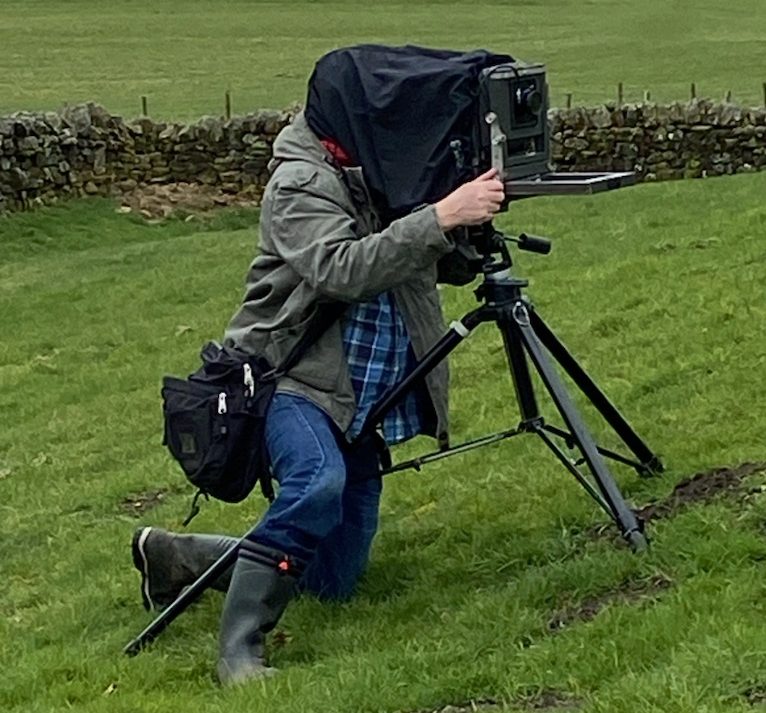Despite living in the North East of England for a little over 50 years, I’d never visited Spittal until this month. Spittal is (arguably) a suburb of Berwick upon Tweed, which lies close to the border between England and Scotland.
It must be said that Spittal on the whole is not fantastically photogenic. There’s a nice enough beach for locals to walk on but you wouldn’t drive 60 miles from Newcastle just to see the beach, because there are numerous better beaches further south in Northumberland, such as Bamburgh, Embleton, Druridge Bay.
The thing that DID attract me to Spittal was an area of rocks just 30m long by 5m wide, consisting of highly weathered layered sandstone; I’d seen a couple of images from my flickr contacts.

For this trip I used my Mamiya RZ67 with either the 110mm or 65mm lenses. Although I’ve been using the Fujifilm GA645Zi a lot recently, this subject needs (a) close focussing, and (b) a big viewfinder so you can check what’s in focus
Working at close range, the depth of field is pretty limited. I wanted most of the scene to be in focus so used f22 for most shots. I used the depth of field preview to try and check the focus, but the screen gets very dim when you step down to f22 so this wasn’t a perfect method. I also tried multiple versions of the same image with varying focus points, with a view to trying out focus stacking, but haven’t got round to trying this yet.


All four images above were taken on Fuji Velvia 50, which I haven’t used much recently as I now generally prefer negative film due to the wider exposure latitude. However I figured that in the absence of any sky or deep shadows, Velvia should be able to handle the dynamic range quite well. The last one was problematic because I accidentally underexposed by maybe two stops (and took three versions with a view to focus stacking, all incorrectly exposed. I think what happened was that I took an accurate meter reading, but failed to transfer those settings to the camera. Although Lightroom was able to pull back an image, I’m not so happy with the result so this scene will be attempted again in the future – providing I can actually find the exact spot.
EDIT – I produced another version by transferring the file from Lightroom to Photoshop and simply using the Auto Colour command. I’m much happier with this version:
After the roll of Velvia was used up I changed to Kodak Portra 400, which of course has a very wide exposure latitude.
I found that the exercise of making these semi-abstract images was a good discipline in composition. The subject matter is just lines, curves, and textures, with colour playing a supportive role. There is no well-recognised version of what a “standard” image should look like, as a point of reference, as there would be with, say, a portrait. There isn’t even a “right way up” as you can turn the images left, right, or upside down to get the result that pleases you … and that might not be the same thing that pleases other viewers.

Portra 400 film
Small differences in camera angle can make a large difference to the composition. I can’t imagine doing this type of image without a tripod because, apart from the practicalities relating to the shutter speed, I needed to study the viewfinder carefully, especially checking the edges for unwanted intrusions.
I hope to go back to Spittal soon. Of course, the key elements will look the same, but the arrangements of trapped small stones, and the sand left behind, will change with each tide; and the intensity and direction of light will also provide different opportunities. The sun was fairly strong on my visit, but I waited for cloud cover before pressing the shutter. I think light cloud would be the optimum situation, and suspect that rain need not stop play.
Apart from the rocks pictured above, another feature I noticed was a stream emerging from a small cliff at the end of the promenade, which obviously had a high iron oxide content, as the rocks around about were heavily red-stained (effectively with rust, which also got left behind on my camera bag and boots).
I didn’t do the scene justice on this visit but will revisit the area around the stream outlet next time.
Now here’s a map which shows you exactly where to find these features. There’s plenty of free parking nearby, and it’s not far to walk from the car parks to the rocks. There’s also a cafe on the sea-front which serves enormous toasted teacakes with jam….




